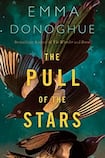
Nurse Julia Power is making her way into work when she spots a new notice, longer than the previous ones, nailed on to the lamppost outside the hospital. “The public is warned,” it says, “to stay out of public places such as cafes, theatres, cinemas and public houses. See only those persons one needs to see. Refrain from shaking hands, laughing, or chatting closely together.”
All sensible advice, it seems, for surviving the year 2020. “If one must kiss, do so through a handkerchief. Sprinkle sulphur in the shoes,” the notice advises.
The year 1918 was rough for humanity. Apart from Debussy dying, and Klimt, and Schiele, the first World War had been going on for so long that it was at playschool age and for those who had thought they’d escaped its carnage, the Spanish flu arrived, about as welcome as honeydew melon in a fruit salad.
The parallels to be made between the Spanish flu and Covid are a writer’s playground, and I fear we may be subject to Covid novels for quite some time, but Emma Donoghue’s latest work, The Pull of the Stars, which is about the Spanish flu, was written before Covid arrived.
The novel came out this week, a mere nine months after Donoghue’s previous novel Akin. When practically every major publishing house has delayed the publication of new books until the autumn and winter, Picador is perhaps the only publisher to have brought a novel’s release forward. The Pull of the Stars was originally slated for a spring 2021 release, but due to its timely plot, the novel has been released over six months early.
The novel follows Nurse Power over three shifts in a Dublin hospital’s maternity/fever ward at the beginning of the Spanish flu epidemic. It is a portrait of a hospital “on the hop”, overcrowded and understaffed. Between the delirious shouting of the infected patients, the rationing of supplies, the high infection rate, and the flu’s effects on pregnant women, which can induce premature birth at a moment’s notice, Nurse Power’s ward seems to mirror the trenches.
During the first day of the narrative, Nurse Power receives a shock in the form of Bridie Sweeney, a young woman of “around twenty-two” who is sent to the ward to lend a hand by the night nurse, Sister Luke. At first distrustful of her “unqualified” and “uneducated” new helper, Nurse Power and Bridie quickly get along like cogs, forming a symbiotic relationship that is a pleasure to read.
Dr Kathleen Lynn
The novel’s most discussed aspect, however, will likely be the inclusion of Dr Kathleen Lynn as a central character. First introduced through whispers of gossip in the ward (“a socialist, suffragette, anarchist firebrand!”), her characterisation is one of a caring and vastly intelligent woman. She is fond of Nurse Power, though this fondness is not always reciprocated. Nurse Power regards the acts of 1916 as pure terrorism and often states this position, and she struggles to respect a woman who had a role in the death and destruction of that Easter weekend.
I am somewhat weary of Donoghue’s version of Dr Lynn in the novel. One of the most discussed aspects of her life was her decades-long lesbian relationship with Madeleine ffrench-Mullen, both of whom went on to found St Ultan’s Children’s Hospital in Dublin the year after the novel’s events. While the novel does progress into queerness, none of it is displayed by Dr Lynn, nor is her queerness ever really hinted at.
I was not expecting Donoghue’s Dr Lynn to be brandishing a rainbow pin on her blouse and humming Phoebe Bridgers songs under her breath as she traverses the ward in her Doc Martens. But when writing one of the most prominent lesbian voices in Irish history into your fictional narrative, would you not consider saying for her what she could never say for herself? Especially as she is one of the few queers of the revolution whose legacy isn’t tainted nor questionable, such as Eoin O’Duffy and his penchant for fascism, or Patrick Pearse and his fascination with young boys.
However, I must admit that Donoghue does deliver with The Pull of the Stars. While the final part is abrupt and clumsily plotted (I question the fast-tracked editing process the novel must have undergone in order to accommodate its early release), Donoghue’s narrative of a nurse in the midst of a pandemic is enticingly written with the not-a-minute-to-waste pace of Dr Lynn.
Its modern parallels do trigger uneasiness (as do its numerous and gloriously explosive birth scenes) but those parallels are what ultimately make The Pull of the Stars a felicitous comment on our new times.









